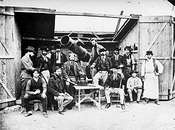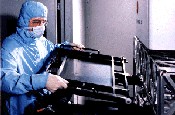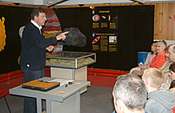A brief history of the Royal Observatory Edinburgh
 Lord Lindsay, Earl of Crawford lead a trip to Cadiz in 1870 to observe the solar
corona during a solar eclipse
Lord Lindsay, Earl of Crawford lead a trip to Cadiz in 1870 to observe the solar
corona during a solar eclipseThe ROE story began when the first Chair of Astronomy within the University was established in 1786, astronomy having been taught in Edinburgh since the opening of the town’s college in 1583. Astronomy in Edinburgh flourished at the Playfair Observatory on Calton Hill – the brainchild of the Astronomical Institution of Edinburgh. Calton Hill became the Royal Observatory during the visit of George IV to Scotland in 1822. The first Astronomer Royal for Scotland, Regius Professor Thomas Henderson, was appointed in 1834. Henderson was the first astronomer to measure parallax and determine the distance to the stars – an achievement that has made him one of Britain’s most famous astronomers.
The next fifty years saw major research advances leading to the futuristic vision of mountain-top observing developed by Charles Piazzi Smyth, second Astronomer Royal for Scotland. However, political times changed and by 1888 the fortunes of the Royal Observatory were at a very low ebb with inadequate buildings, outmoded instruments, an unsuitable site and a paltry budget. A Royal Commission recommended that the Edinburgh Observatory should cease to be a national Scottish institution and that its buildings should be handed over to the University.
This fate was averted by the generosity of the Earl of Crawford. In return for the gift to the nation of the contents of his splendidly equipped observatory in Aberdeenshire and of his magnificent library, the government agreed to build and maintain a new Royal Observatory on the Blackford Hill site. This new Observatory, designed and equipped under the supervision of the new Astronomer Royal for Scotland, Ralph Copeland, came into being in 1896. The site included the new residence of the Astronomer Royal. Site, materials, buildings and embellishments were all carefully selected to provide an altogether superb public monument to astronomy as well as a state-of-the-art research centre. The gift of the Crawford Collection, one of the greatest collections of astronomical books in the world, was, and continues to be, the historical heart of an institution at the leading edge of science and technology.
In the following decades, the Royal Observatory attained and maintained a position at the forefront of UK - and indeed world astronomy, the underlying technologies and the young science of astrophysics. 1930 saw the historic installation of the 36-inch reflector telescope in the East Dome. In 1951 the 14/24-inch Schmidt telescope was installed in the West Dome and in 1963 a twin 16-inch automated photometric telescope.
 Loading a plate into SuperCOSMOS
Loading a plate into SuperCOSMOSFrom 1957 onwards the ROE became even more clearly a world leader, continuing to develop automation techniques, especially important given the vast amount of information contained in the photographic plates from the new Schmidt telescope. GALAXY, an automatic measuring machine for these plates, came on stream in 1970. This machine was the precursor of the SuperCOSMOS computer currently in operation on Blackford Hill. The efforts of the Observatory were concentrated into technology, instrumentation and engineering. Meanwhile, astronomy worldwide was moving increasingly to the use of telescopes at remote mountain sites, exactly as predicted by Piazzi Smyth. With its technological expertise, the ROE was very well placed. The 1970s and 80s saw the ROE take responsibility for the creation and operation of the UK Schmidt Telescope in Australia, the UK Infrared Telescope in Hawaii and the James Clerk Maxwell Telescope, again in Hawaii. The ROE was truly "the observatory on which the sun never sets".
The 1990s saw major developments at the ROE. The three roles: Director of the ROE, Regius Professor of Astronomy within the University and Astronomer Royal for Scotland were separated. More importantly, the Particle Physics and Astronomy Research Council which funded the ROE decided to run the overseas observatories as independent entities, to close the Royal Greenwich Observatory, and to focus the instrument building capabilities of the UK within one organisation, the United Kingdom Astronomy Technology Centre, on Blackford Hill. To emphasise this focus, the functions of the government side of the old ROE outwith that of instrumentation were incorporated in the Institute for Astronomy (alongside its teaching and research), headed by the Regius Professor. The title of Astronomer Royal for Scotland was freed from its previous tie to Edinburgh, thereby giving it an independent voice.
 Open Day 2003: Meteorite handling in the Visitor Centre
Open Day 2003: Meteorite handling in the Visitor CentreIn this way, the ROE continues to develop as a leading force in UK and world astronomy. Its potent mix of activities on Blackford Hill- research, astronomical instrumentation and public understanding of science via a Visitor Centre - continue to thrive.
